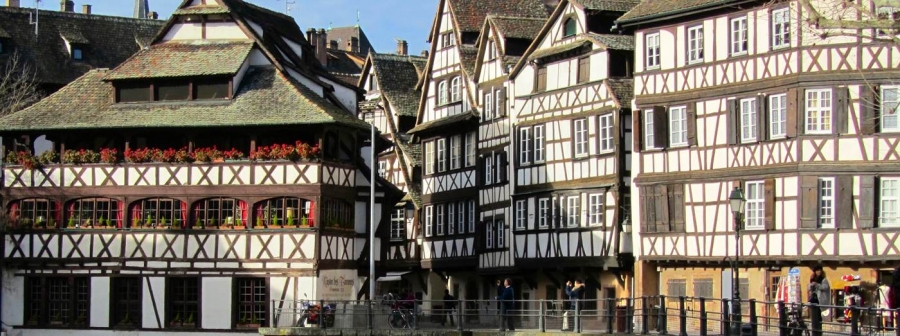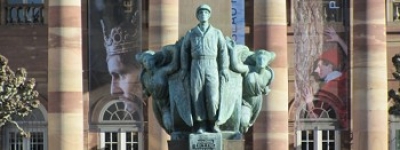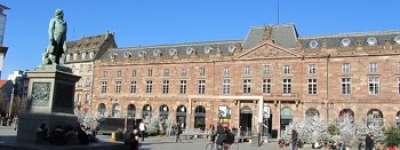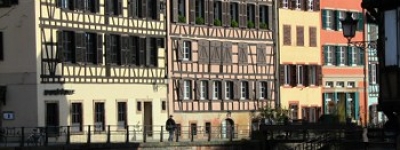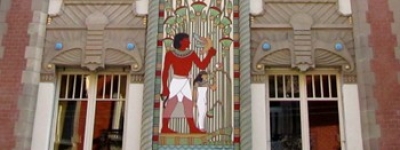World Heritage
The Grande Ile of Strasbourg (literally, Big Island) is a remarkable urban ensemble, characteristic of the center of Europe, and a unique example of settlement in the Rhine valley during the 15th and 16th centuries. The city was the vector for the movement of Gothic art toward the east.
Surrounded by two arms of the Ill River (which runs through the center of Strasbourg), the Grande Ile is the historic center of the Alsatian capital. This was the site of the Roman castrum of Argentorate, of which the two main axes have remained despite the growth of the modern city. The Grande Ile contains a remarkable monumental complex within a very small space.
The cathedral, whose single spire dominates the Alsatian plains, and the four ancient churches, Saint Thomas (7th-15th centuries), Saint-Pierre-le-Vieux (8th – 15th centuries), Saint-Pierre-le-Jeune (7th-15th centuries) and Saint-Étienne (7th century), are more than isolated monuments: they are closely based on the typical structure of a medieval city, and reflect the changes in Strasbourg at this time. The cathedral, which is the main monument of the site included on the World Heritage list, illustrates this historic and urban coherence.
The dense network of streets populated by shopkeepers and craftsmen offer the very image of a medieval city and post-medieval Christian society.
Public buildings such as the old City Hall (1585, the current Chamber of Commerce) or the city’s Grande Boucherie (slaughterhouse) (1587-1588, now the Museum of History) exist alongside hotels (Hotellerie du Cerf), boutiques and workshops, as well as elegant patrician houses (Maison Kammerzell or the houses along Rue Mercière, Rue du Vieux-Marché-aux-Poissons and elsewhere).
In 2017, UNESCO completed the classified area including the most significant elements of the new town (Neustadt) that are related to the old town visually and in landscape terms. In the Neustadt, the administrative centre, built around the Kaiserplatz (today the Place de la République), is linked to the University Palace via the imperial axis. The creation of the Neustadt, designed and built under the German administration (1870-1918) while respecting the urban heritage, reinforced the bi-cultural character of the city, and culminated in a picturesque urban landscape characterised by the strong presence of water.
The Grande-Île and the Neustadt form an urban ensemble that is characteristic of Rhineland Europe, with a structure that centres on the cathedral, a major masterpiece of Gothic art. Its distinctive silhouette dominates the ancient riverbed of the Rhine and its man-made waterways. Perspectives created around the cathedral give rise to a unified urban space and shape a distinctive landscape organized around the rivers and canals.
The French and Germanic influences have enabled the composition of a specific urban space combining constructions reflecting major significant periods of European history: Roman Antiquity, the Middle Ages and the Rhineland Renaissance, French 18th century classicism, and then the 19th and early 20th centuries which saw the emergence of a modern city, the capital and symbol of the new German state.
Criteria for selection
Criterion (ii): French and Germanic influences have shaped the Grande-Île and Neustadt. They have enabled the emergence of a unique expression coming from the two cultures, which is especially conveyed in the fields of architecture and urbanism. The cathedral, influenced by the Romanesque art of the East and the Gothic art of the kingdom of France, is also inspired by Prague, particularly for the construction of the spire. It is a model that acted as a vector of Gothic art to the east. The Neustadt, a modern city forged by Haussmannian influences, and a model of urbanism, also embodies the theories of Camillo Sitte.
Criterion (iv): The Grande-Île and the Neustadt in Strasbourg constitute a characteristic example of a European Rhineland city. Integrated into a Medieval urban fabric in a way which respects the ancient original fabric, the Renaissance-style private residences built between the 15th century and the late 17th century form a unique ensemble of domestic Rhineland architecture, which is indissociable from the outstanding Gothic cathedral. In the 18th century, French classical architecture became dominant, as exemplified by the Palais Rohan, built by the king’s architect, Robert de Cotte. From 1871 onwards, the face of the town was profoundly modified by the construction of an ambitious urbanistic project, leading to the emergence of a modern, functional city, emblematic of the technical advances and hygienistic policies that were emerging at the turn of the 19th and 20th centuries. The private and public buildings of the urban ensemble bear witness to political, social and cultural change, with the town’s status changing from a free city of the Holy Roman Empire to a free city of the Kingdom of France, before it became a regional capital.
Source : Unesco / ICOMOS
History
History of Strasbourg
The Romans implanted a camp on the site of the Grand Ile in 12 BC : Argentorate. The legionaries who occupied the garrison fortified it during the following centuries with ramparts of stone and brick. The town grew west of the military camp along the axis of the Grand’Rue and around the current streets Rue du Dôme and Rue des Hallebardes. Significantly damaged by Attila in 451, the city was rebuilt and refurbished by the Franks, who promoted the development of the city after the conversion of Clovis to Christianity. It became Strateburgum in 496. The urban organization from this period is still visible today.
The city grew, and its geographical location at the crossroads of several trade routes allowed for continuous development and prosperity, resulting in the creation of a bishopric from the Merovingian era onward. Until the 13th century, the bishop was the true master and governor of the city. Under his leadership many religious buildings emerged (cathedral, parishes). The city continued to thrive and expand. It was not until 1262 at the Battle of Hausbergen that powers were transferred to the city’s public figures and bourgeoisie, which provoked a period of unrest due to power struggles. It became a small independent republic, part of the Holy Roman Germanic Empire. At that time, the city held an annual trade show and produced its own currency. Protected behind its imposing walls and guns, it benefitted from its location at the crossroads of trade routes to prosper again from the 14th century onward, a prosperity that was almost never interrupted. The city experienced its golden age around the 15th century, and many buildings still bear witness to this period.
Gutenberg, child of the city, invented the printing press in 1450. And the city was thus at the origin of a new intellectual ferment that influenced all of Europe. During this period, the city adopted the religious reforms and allocated churches to the Protestant denomination. But soon, war would break out between the Protestant League and the Emperor Charles V, a Catholic. Defeated, Strasbourg was forced to render the cathedral and two churches to the Catholics.
In 1681 the city was attached to the kingdom of France by Louis XIV following the defeat of the Holy Roman Empire during the Thirty Years War, but it retained some of its independence and many rights, especially in religious matters. Its location on the border of the kingdom of France became a strategic military point, ideal for hosting a large garrison. The city resumed its growth and a new era of prosperity began.
The city was then embellished with a new architecture, in a distinct "French” style, examples of which include the Rohan Palace, and the mansions of Rue Brûlée and Rue de la Nuée Bleue.
In 1870 war broke out between France and Prussia. The latter won the conflict, as well as Alsace and part of Lorraine. The following year the creation of the German Empire was decreed and Strasbourg became the capital of the new "Reichsland" Alsace-Lorraine. New neighborhoods were created northeast of the Grande Ile, called the Neustadt (new city).
The Neustadt was designed and built from the 1870s onwards. The construction project was intended to showcase German knowhow and excellence in the capital of the Reichsland of Elsass-Lothringen. It also led to the development of the concept of the large city (Groβstadt), in which engineering, architecture and urbanism are combined to create the urban landscape.
The construction of the Neustadt, for which huge resources were made available, tripled the area of the city, and doubled its housing capacity. The administrative centre, consisting of a group of buildings centring on the Kaiserplatz (today the Place de la République) – the Emperor’s palace, the ministries, the imperial library and the regional parliament – was linked along the imperial axis to the University Palace. All these buildings and urban areas are included in the proposed extension. The university, designed in the mid-1870s, is one of the major poles of attraction of the new town.
Visual continuity in the architecture of the initial property and the proposed extension was made possible by the genesis, after 1870, of a local regionalist movement represented by a group of architects and the emergence of an “Alsatian Renaissance”. This was reflected in the protection of the monuments and the defence of regional building and craft traditions.
Begun before the outbreak of the First World War, the works of the Great Breakthrough would rearrange the urban structure while maintaining the historic center and its medieval organization. Returned to the French Republic after the Great War, the city continued its development between the new railway station and the river port.
But soon the Second World War would ravage France, and Alsace was again annexed by Germany. Liberated from German rule on the November 23rd, 1944 by the troops of General Leclerc, Strasbourg once again returned to France and regained its prosperity. Strasbourg became the center of Europe and was chosen to host the headquarters of the Council of Europe and the European Parliament.
The pedestrianization of the city center and the development of public transport such as the tramway, were also instrumental in changing the means of transportation in the old town, and today offer visitors a pleasant environment for exploring its history and its exceptional architecture.
Tourist Office
Strasbourg Tourist Office
Tourist Office
17 Place de la Cathédrale, 67000 Strasbourg
Website - tel : 03 88 52 28 28.
Open daily: 9 a.m. to 7 p.m.
This is where you can buy the Strasbourg-Pass. The leaflet "Strasbourg Facile" (Strasbourg, the easy way) offers a walking itinerary specially designed for those with disabilities. For toddlers, strollers can be borrowed. These services are available in the branches of the Tourist Office.
Tours organized by the Strasbourg Tourist Office
Walking tour with an audio guide (duration: 1 hour, 30 minutes)
Full price / reduced price: €5.50 / €2.75. Free for children under 12 years old.
Languages: French, German, Italian and Spanish. Available for rent at the Tourist Office.
Guided tours on foot in English
"The Old Town, from the cathedral to the Petite France" (duration: 1 hour, 30 minutes)
Full price / reduced price: €8,50 / €5. Free for children under 12 years old
In May, June, September, October and December, on Saturdays at 3 p.m.
To discover the city in a different way, based on themes such as: secret stairways, famous figures, strange streets, the mysteries of the cathedral ... Departure from the Tourist Office. Visit accessible to those with reduced mobility.
The Tourist Office offers other guided theme tours: the astronomical clock, the historic wine cellar of the city hospital, Jewish heritage, museums ...
Good deals for visitors
Strasbourg-Pass and Strasbourg-Pass Junior
Price: adult: €19.50, children between 13 and 17 years old: €15, children between 4 and 12 years old: €10.
The Strasbourg-Pass opens the gates of the city for 3 days.
The Strasbourg-Pass includes vouchers for admission to a museum of your choice, a trip to the platform of the cathedral, access to the astronomical clock show in the cathedral, a tourist boat ride and a bicycle rental for half a day. Other discounts include 50% off the price of : a 2nd museum visit, the audio tour of the old town, the scenic mini-train, a walking tour ... a really good bargain for visitors. Sale and information available at the Tourist Office.
Good deals for family
The Familiciti
The Tourist Office offers a practical guide for activities and visits for the whole family, as well as lots of other information (entertainment, childcare ...).
The Familicitirali
A discovery circuit downtown for the whole family, the "Familicitirali" is free with the Strasbourg-Pass Junior .
Boutique Culture
10 place de la Cathédrale, 67000 Strasbourg
Tel : 03 88 23 84 65.
Open Tuesday to Saturday: 12 p.m. to 7 p.m.
Learn all about the cultural programs and buy tickets for shows. Located in the old Cerf Pharmacy. See "Place de la Cathédrale".
Museums
Main museums of Strasbourg
Museums of the Palais Rohan (Musée des Arts Décoratifs, Musée des Beaux-Arts, Musée Archéologique).
2 Place du Château, 67000 Strasbourg
Website - tel : 03 68 98 51 60.
Full price / reduced price: €6.50 / €3.50. Free for those under 18 years old. Free for all the first Sunday of each month.
Open every day except Tuesday: 10 p.m. to 6 p.m.
The three museums of the Rohan Palace are accessible to those with disabilities.
Snacktime workshops are organized for children, Wednesday and Saturday.
The Musée des Arts Décoratifs
This museum presents a few reconstructions of the apartments of the cardinals. Their staging restores the lavish interiors in the region from the 17th to the 19th century. Of note in particular is the magnificent collection of world famous Hannong ceramics. Also on display are high quality decorative arts such as furniture, clocks, ironwork, pottery and jewelry.
The Musée des Beaux-Arts
Located on the first floor of the Palace, the museum has a fine collection that consists of masterpieces of the great European painters of the 14th century to 1870 (Botticelli, Raphael, Correggio, Veronese, Le Greco, Rubens, Goya, Corot, Delacroix, Courbet, etc.).
The Musée Archéologique
In the basement of the Palace, the Archaeological Museum is one of the largest in France in the scope of its collections that trace the history of the region from 600,000 BC to 800 AD. It houses tombs, weapons, jewelry, even a mammoth jaw .... A veritable invitation for a journey through time.
Maison et musée de l’Œuvre de Notre-Dame
3 Place du Château, 67000 Strasbourg
Website - tel : 03 68 98 51 60.
Full price / reduced price: €6.50 / €3.50. Free for those under 18 years old. Free for all the first Sunday of each month.
Open daily except Monday : 10 a.m. to 6 p.m.
Accessible to those with disabilities. Free audio guide.
The Works of Notre-Dame was created during the construction of the cathedral to coordinate work and raise funds for its implementation and maintenance. It housed the administration and stonemason workshops.
The museum that has been housed within its walls since 1931 has many statues from the cathedral that were submitted to escape destruction during the Revolution, as well as an exceptional collection of architectural drawings of the cathedral from the 13th century. The museum is not only dedicated to the cathedral; visitors will also find collections of still life paintings, decorative arts, fine stained glass and Alsatian objects from the 15th to the 18th centuries. An adjoining Gothic garden, built in 1937, completes the circuit. Visitors will notice the famous "Head of Christ", the oldest known figurative stained glass (11th century), and medicinal plants cultivated since the Middle Ages.
Musée Historique de la ville de Strasbourg
2 rue du Vieux Marché aux Poissons, 67000 Strasbourg
Website - tel : 03 68 98 51 60.
Full price / reduced price: €6.50 / €3.50. Free for those under 18 years old. Free for all the first Sunday of each month.
Open Tuesday to Sunday: 10 a.m. to 6 p.m.
Accessible to those with reduced mobility. Free audio guide. Information available in French, German and English.
Games and activities for children throughout the museum circuit.
La Grande Boucherie (slaughterhouse) was built in 1587, replacing a former slaughterhouse that had become dilapidated and unsafe. The entire neighborhood was dedicated to the food industry, and the various food-themed names of the surrounding streets confirm this. Butchers’ stands were located on the side of the main street, and the other part of the building served as a stock room.
Installed here since the early 20th century, the museum traces the history of the city (urban planning, politics, economics, arts and culture) around three chronological themes: the free city of the Holy Roman Germanic Empire (1262-1681), the Royal City (1681-1789) and the birth of a metropolis (19th and 20th centuries). The museum also features a fine collection of paintings, prints and period objects, including an immense, precise relief map of Strasbourg commissioned by Louis XV (1727).
Musée Alsacien
23-25 quai Saint Nicolas, 67000 Strasbourg
Website - tel : 03 88 52 50 01.
Full price / reduced price: €6.50 / €3.50. Free for those under 18 years old. Free the first Sunday of each month.
Open every day except Tuesday:10 a.m. to 6 p.m.
Accessible to those with disabilities.
This museum of arts and popular traditions presents rural life in Alsace during the 18th and 19th centuries. The museum circuit meanders through ancient and magnificent Strasbourg mansions. It has thousands of objects (costumes, furniture, ceramics, toys ...), interior reconstructions and artisan workshops.
Musée d’Art Moderne et Contemporain de Strasbourg (MAMCS)
1 Place Jean-Hans Arp, 67000 Strasbourg
Website - tel : 03 68 98 51 55.
Full price / reduced price: €7 / €3.50. Free for those under 18 years old. Free for all the first Sunday of each month.
Open Tuesday to Sunday: 10 a.m. to 6 p.m.
Accessible to those with disabilities and reduced mobility.
Library. Restaurant. Bookshop.
In a futuristic building of glass and pink sandstone, the Museum of Contemporary Art features permanent collections and temporary exhibitions from 1870 to the present day.
It includes collections of Modern Art, Impressionism, decorative arts, primitivism, the beginnings of abstraction and Surrealism of Western Europe. The museum presents a mix of work by Gustave Doré (an entire gallery devoted to it), Jean Arp, Kandinsky, Picasso, Brauner, Ernst, Monet, Gauguin ... Many events are also scheduled here throughout the year (concerts, performances, graphic art ...). The terrace along the Ill River overlooks the district of Petite France and the Covered Bridges.
Musée Tomi Ungerer
2 Avenue de la Marseillaise, 67000 Strasbourg
Website - tel : 03 68 98 51 53.
Full price / reduced price: €6.50 / €3.50. Free for those under 18 years old. Free for all the first Sunday of each month.
Open every day except Tuesday: 10 a.m. to 6 p.m.
Accessible to those with disabilities.
Located at the Villa Greiner. Tomi Ungerer, cartoonist and illustrator born in Strasbourg in 1931, donated a large collection of his drawings to the city. Ground floor: drawings, books, posters for children ; First floor: advertising and satirical drawings ; Basement: erotic and macabre works. The museum can be discovered with the whole family. Note, however, that some drawings are aimed at children, and other for adults.
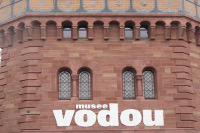
Vodou Museum
4 Rue de Koenigshoffen, 67000 Strasbourg
Website - Tel: 03 88 36 15 03.
Full price/ reduced price: €14/ €8.
Audio tour in French, German or English.
Château Vodou, unique in its kind, houses the largest private collection of West African Vodou objects in the world.
All the objects presented were used in religious practices: ancestor worship, medicine, divination, witchcraft or other events related to the major stages of life.
Thanks to a sensitive scenography, the public is invited to discover a little-known culture and a philosophy of life that is still widely practiced today.
The collection, originating from Ghana, Benin, Togo and Nigeria, reveals its secrets in an exceptional setting: a water tower from 1878.
Cave Historique des Hospices de Strasbourg
1 Place de l’Hôpital, 67000 Strasbourg
Website - Tel: 03 88 11 64 50.
Entrance free. Audio-guide available.
Opening time:
Monday to Friday: 8:30 a.m. to 12 p.m. / 1:30 p.m. to 5:30 p.m., Saturday: 9 a.m. to 12:30 p.m.
Created at the end of the 14th century, the historic cellar of the Hospices of Strasbourg allowed the religious who managed the hospital to be able to achieve self-sufficiency in food and to live in autarky. You will be able to discover a white wine of 1472, the oldest wine in the world! The cellar thus produces many wines available for sale. The profits made are given to the Hospitals of Strasbourg.
Events
Main events of the year in Strasbourg
The printemps des Bretelles (end of March)
Website - tel : 03 88 65 31 06.
Festival that celebrates the accordion.
Jazzdor (June)
Website - tel : 03 88 36 30 48.
Cathedral illuminations (July and August)
Every evening, from 10.30 pm to 0.30 am, in the Cathedral square.
Musica (end of september)
Website - 03 88 23 46 46
.
In the Cité de la musique et de la danse. Contemporary music.
European Contemporary Art Fair (end of November)
Site internet
Christmas market (December)
Place Broglie, Place du Château and Place de la Cathédrale
The oldest Christmas market in France. Many shows, illuminations, nativity scenes, concerts ...
Markets in Strasbourg
Traditional market
Place Broglie, Wednesday and Friday all day.
Farmers and Artisanal Market
Place du Marché Neuf, on Saturday: 7 a.m. to 4 p.m.
Transport
Getting to Strasbourg
By car
From the west (Paris), the north or east (Germany): highway A4, exit n° 51 "Strasbourg-Centre".
From the south (Lyon): highway A35, exit n° 2 "Place des Halles."
Nearby classified sites:
Nancy: 160 km (99 mi), time: 1 hour, 55 minutes
Arc et Senans (royal salt mines): 290 km (180 mi), time: 3 hours, 15 minutes
By Plane
Strasbourg-Entzheim international Airport
Route de Strasbourg, 67960 Entzheim
Website - tel : 03 88 64 67 67.
Strasbourg-Entzheim International Airport is located 10 kilometers from downtown Strasbourg via highway.
Getting to the city center:
Website - tel : 08 00 77 98 67.
The airport is served about 2 times per hour by train. The Entzheim train station is located opposite the airport. Allow 10 minutes to reach the center of Strasbourg.
Euroairport Bâle Mulhouse Fribourg
68304 Saint Louis
Website - tel : 03 89 90 31 11.
Getting to Strasbourg
By car : 1h15.
By shuttle:
Alsace Navette Aéroport :
2 rue du Coq, 67000 Strasbourg
Website - tel : 06 27 18 12 52.
Strasbourg Navette:
Website - tel : 03 88 61 02 97 or 06 30 24 85 59.
Karlsruhe/Baden-Baden Airport
(In Germany, 58 km from Strasbourg)
Victoria Boulevard A 106
D-77836 Rheinmünster
Website - Tél. (+49) 72 29 66 20 00
Served by RyanAir.
Shuttle to Strasbourg:
Duration: 1 hour
By train
Gare SNCF
3 boulevard du président Wilson, 67000 Strasbourg
Website – tel : 36 35.
Paris to Strasbourg in 2 hours, 20 minutes, with 16 daily round trips.
Getting around Strasbourg
Good deals for parking
10 Relais-Tram parking lots offer the possibility to park vehicles near a tram station and access the city center in few minutes, without the hassle of traffic or finding a parking spot. In exchange for a daily parking fee €4.10 per vehicle, all occupants receive a round-trip tram ticket. Relais-Tram parking lots are open from Monday to Saturday from 7 a.m. to 8 p.m. Beyond opening hours parking is free, but tram tickets are not included. For more info: Website
Public Transport
CTS (Compagnie des Transports Strasbourgeois)
14 Rue de la Gare-aux-Marchandises, 67000 Strasbourg
Website - tel : 03 88 77 70 70.
Price: €1.70 one-way or €2 if you buy it on board.
The public transport network of Strasbourg has 29 bus lines and 6 tram lines. The tramway accesses the major points of interest in the city.
Cycling
500 kilometers of bike paths.
CADR67, Maison des Cyclistes
12 rue des Bouchers, 67200 Strasbourg
Website - tel : 03 88 75 17 50.
Here you will find an area dedicated to bicycle tourism, maps of bike paths, discovery circuits and a free self-service bike maintenance area.
Bike rental
Esprit Cycles
18 rue Jacques Peirotes, 67000 Strasbourg
77 avenue de la Forêt Noire, 67000 Strasbourg
Website - tel : 03 88 36 18 41.
Rentals: road and mountain bikes, tandems, transporters, electric bikes
Velhop
Gare de Strasbourg
, 67000 Strasbourg
3 rue d’Or, 67000 Strasbourg
23 boulevard de la Victoire, 67000 Strasbourg
Website - Tel: 09 60 17 74 63.
Self-service shared bike system. Price: €1 per hour, €5 for 12 hours.
Visit Strasbourg by bike or bicycle-rickshaw
Cyclorama
99 rue du Polygone, 67100 Strasbourg
Website - Tel: 06 16 56 22 62.
Bicycle-rickshaw ride from €30.
Bike tour, full visit of Strasbourg. Price €35/pers. Duration: 2 hours 30 minutes.
Boat tour
Batorama
18 Place de la Cathédrale, 67000 Strasbourg
Website - tel: 03 69 74 44 04.
Full price / reduced price: €13.50 / €7.80. Free for children under 4 years old
Open daily. Pier: Palais Rohan. Duration: 1 hour, 10 minutes
Accessible to persons with reduced mobility upon request.
Two circuits allow visitors to see the city from the river and discover its rich heritage scattered along the banks. Individual audio commentary in 12 languages for adults and in 4 languages for the children’s audio guide. You can buy the ticket at Batorama boutic, on the Cathedral square.
Mini-train
The Touristic Train
Website - tel : 03 89 73 74 24.
Full price / reduced price: €7 / €5. Free for children under 6 years old.
Runs from Mid-March to November 11th.
Depart: Place de la Cathédrale.
Accessible to persons with reduced mobility upon request.
From the cathedral, the mini-train crosses the city center into the Petite France. Multilingual commentary.
Carriage Rides
4 rue de Dorlisheim, 67560 Rosheim
Runs during the Christmas market.
Tour of the heart of Strasbourg in a double-decker carriage. Seats 28 people on two levels.
Sleeping / Eating
Hotel in Strasbourg
Régent Petite France *****
5 Rue des Moulins, 67000 Strasbourg
Website - Tel: 03 88 76 43 43.
Room from €179.
Restaurants in Strasbourg
The selection of restaurants proposed below consists of restaurants that offer a good price/quality value. These addresses are inside the classified area. “Formule” corresponds to a lunch special with a starter and a main course, or a main course and a dessert. The “menus” usually consist of a starter, a main course and a dessert," for lunch or dinner.
L’épicerie - tartines
6 Rue du Vieux Seigle, 67000 Strasbourg
Website - tel : 03 88 32 52 41.
Tartines : €5, courses around €12.
Zuem Strissel – Alsatian cuisine (winstub)
5 place de la Grande Boucherie, 67000 Strasbourg
Website - Tel: 03 88 32 14 73.
Main course around €20.
La Corde à Linge – local cuisine
2 Place Benjamin Zix, 67000 Strasbourg
Website – tel : 03 88 22 15 17.
Main course around €15.
Au Coin des Pucelles – local cuisine
12 Rue des Pucelles, 67000 Strasbourg
Website - Tel : 03 88 35 35 14.
Main course from €15.
La Cambuse – gourmet seafood cuisine
1 rue des Dentelles, 67000 strasbourg
Tel : 03 88 22 10 22.
"Menu" from €46.
Maison Kammerzell – traditional Alsatian cuisine and sauerkraut
16 Place Cathédrale, 67000 Strasbourg
Website - tel : 03 88 32 42 14.
Sauerkraut from €21.90. Other main course around €25.
Restaurant Chez Yvonne - inventive winstub
10 Rue du Sanglier, 67000 Strasbourg
Website - tel : 03 88 32 84 15.
"Lunch formule" : €21. "Menu" from €27.
Le Tire-Bouchon – gourmet local cuisine
5 Rue des Tailleurs de Pierre, 67000 Strasbourg
Website - tel : 03 88 22 16 32.
"Lunch Formule" €10.50. "Menu" from €24.90.
Maison des Tanneurs – traditional alsatian cuisine
42 rue du Bain aux Plantes, 67000 Strasbourg
Website - Tel: 03 88 32 79 70.
Main course around €25.
Le Clou – winstub (traditional Alsatian cuisine)
3 Rue du Chaudron, 67000 Strasbourg
Website - tel : 03 88 32 11 67.
Main course around €20.
La Table de Christophe – cuisine from the market
28 Rue des Juifs, 67000 Strasbourg
Website - tel : 03 88 24 63 27.
"Lunch formule" : €13.90. Main course around €20.
La Casserole - gourmet cuisine
24 Rue des Juifs, 67000 Strasbourg
Website - tel : 03 88 36 49 68.
"Lunch menu" : €39. "Dinner menu" : €55.
Reservation is essential.
Au Crocodile – traditional cuisine revisited
10 rue de l'Outre, 67000 Strasbourg
Website - tel: 03 88 32 13 02.
"Lunch menu" €48. "Dinner menu" €108.
Au Pont du Corbeau - winstub
21 Quai Saint-Nicolas, 67000 Strasbourg
Tel : 03 88 35 60 68.
"Menu" from €29.
Outside the classified area
La Choucrouterie – sauerkraut
20 Rue Saint-Louis, 67000 Strasbourg
Website - tel : 03 88 36 52 87.
Sauerkraut from €16.
Brasserie des Haras – fine Alsatian cuisine
23 Rue des Glacières, 67000 Strasbourg
Website - Tel: 03 88 24 00 00.
"Lunch formule": €25. Main course around €25.

